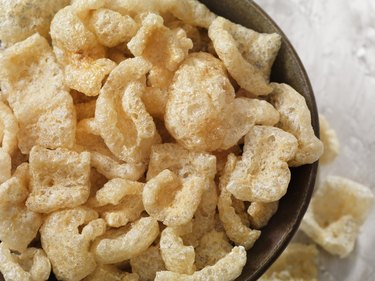
Pork skins, also known as pork rinds, are a crunchy fried snack food. Are pork skins healthy? Consider this — they are made by chopping, cooking and smoking pieces of pork skin, before deep-frying the pieces in 400-degree-Fahrenheit lard.
The frying process causes the skins to puff up, giving pork rinds their unique, airy and crunchy texture. Pork rinds are often marketed to low-carb dieters because they are a quick and crunchy snack food high in protein and contain no carbohydrates, unlike other chips and convenience-store snacks. However, there are also a significant amount of pork skin calories.
Video of the Day
Video of the Day
Pork Skin Nutrition: Macronutrients
Consider the macronutrients in pork skin nutrition before indulging in this snack. One ounce of fried pork skin contains 160 calories, with 90 calories — more than half — coming from fat, according to USDA FoodData Central. For a fried snack food, pork skins are high in protein, containing 18 grams of protein.
There are no carbohydrates, making pork skins a low-glycemic food, with little impact on blood sugar. According to the National Academies of Sciences, proteins should make up 10 to 35 percent of your diet. Pork skins can easily fit into your daily diet, if you practice portion control.
Consider the Salt
Pork skins don't contain any sugar or fiber, but they can be very high in sodium. A 1-ounce serving contains 520 milligrams of sodium. According to the American Heart Association, adults should consume no more than 2,300 milligrams of sodium daily; if, however, you have high blood pressure, an increased risk of heart disease, diabetes, are over 51 years old or are African American, the recommended daily allowance is 1,500 milligrams.
For comparison, one serving of potato chips has 148 milligrams of sodium, while nacho cheese flavored tortilla chips have 200 milligrams , according to the USDA.
Read more: Is Pork Better Than Beef?
Watch the Serving Size
Pork skins are higher in protein than other crunchy snack foods such as potato chips or nacho cheese tortilla chips, but they may also be higher in fat and salt content. A 1-ounce serving of potato chips has about the same number of calories and calories from fat as pork skins.
Potato chips also contain 15 grams of carbs, 0.09 grams of sugar and 0.87 grams of fiber. Nacho cheese tortilla chips have slightly fewer calories and less fat, but have 18 grams of carbs, 1 gram of sugar and 2 grams of fiber.
Many less-healthy foods, including pork skins or rinds, can be eaten in moderation, as part of a balanced diet. Pork skins often come in 2- or 2.5-ounce bags. Pay attention to serving sizes — eating 2.5 ounces of pork skins will provide almost 400 calories and 25 grams of fat — more than a quick snack should contain.
The high protein and fat content should help fill you up, and because pork skins contain no sugars or carbs, they won't raise your blood sugar like candy, cookies or snack cakes.